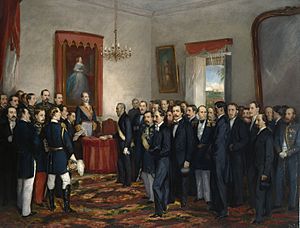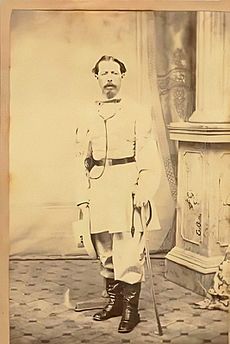Spanish occupation of the Dominican Republic facts for kids
Quick facts for kids
Spanish occupation of the Dominican Republic
|
|||||||||
|---|---|---|---|---|---|---|---|---|---|
| 1861–1865 | |||||||||
 |
|||||||||
| Status | Spanish colony | ||||||||
| Capital | Santo Domingo | ||||||||
| Common languages | Spanish | ||||||||
| Government | Monarchy | ||||||||
| Queen | |||||||||
|
• 1861–1865
|
Isabella II of Spain | ||||||||
| Captain General | |||||||||
|
• 1861–1862
|
Pedro Santana | ||||||||
|
• 1864–1865
|
José de la Gándara | ||||||||
| History | |||||||||
|
• Established
|
1861 | ||||||||
|
• Restoration of Dominican sovereignty
|
1865 | ||||||||
| Currency | Santo Domingo peso, Spanish peso | ||||||||
|
|||||||||
The Spanish occupation of the Dominican Republic (in Spanish: Ocupación Español de la República Dominicana) was a short time when Spain took control of the Dominican Republic again. In 1861, a Dominican general named Pedro Santana asked Queen Isabella II to make the Dominican Republic a Spanish colony once more. This happened after the Dominican Republic had been independent for 17 years.
The Dominican Republic was still recovering from the Dominican War of Independence (1844–1856). In that war, they had won their freedom from Haiti. The Spanish Queen and her government had not liked the peace treaties signed after losing some of their colonies. So, they were happy to agree to Santana's idea and make the Dominican Republic a colony again.
However, the American Civil War ended in 1865. The United States then strongly supported the Monroe Doctrine. This rule meant European countries should not try to control nations in the Americas. The U.S. military was also much stronger after its war. Because of this, Spain decided to pull its troops out of the Dominican Republic. They left in 1865 and went back to Cuba.
Contents
Spain Returns to Santo Domingo
Spanish soldiers arrived in Santo Domingo. They came to support Spanish government workers and priests. These new Spanish officials took over jobs from Dominicans. In just a few months, 6,000 Spanish soldiers were on the island. Soon, this number grew to 30,000 soldiers. They also had twenty-two warships.
Soldiers from Cuba and Puerto Rico joined them. More than 12,000 Dominicans also served the Spanish Queen. These Dominicans were mainly from areas like Azua, Santo Domingo, El Seibo, and the town of Baní.
Early Resistance Efforts
At first, only a few Dominicans fought against the Spanish. This was mostly because they did not have enough weapons. On May 2, 1861, Colonel José Contreras led a group against a Spanish fort in Moca. But Santana, leading his own fighters, caught them. The leaders were then executed.
Soon, Dominicans who had fled to Haiti started to attack from across the border. In June, General Francisco del Rosario Sánchez and José María Cabral began a more organized rebellion. However, Santana tricked Sánchez into a trap at El Cercado. Sánchez was captured and executed with twenty-one of his followers. Spain sent a fleet to Haiti's capital, Port-au-Prince. They demanded money and a promise that Haiti would stop helping the rebels.
Fighting Styles and Challenges
Over time, the fighting methods became clear. The Spanish had better cannons and rifles. They preferred to fight from a distance. The Dominicans knew the land well. They liked to fight up close using spears and sharp weapons.
Santana felt he and his followers were not getting enough rewards. Spanish rule was also becoming very unpopular. So, Santana resigned on March 28, 1862. A Spanish official named Felipe Ribero y Lemoine took his place. He was not a good leader. To make things worse for Spain, a disease called yellow fever spread in the summer of 1862.
Growing Uprisings and Guerrilla Warfare
By 1863, rebellions were happening all over Santo Domingo. Guerrilla warfare, where small groups use surprise attacks, broke out. In February, the Spanish government declared a state of emergency. In April, the Spanish Army defeated Dominicans led by General Lucas de Peña at Cibao.
In August, Dominican rebels worked with Haitian rebels. They created safe places along the Haitian-Dominican border. On August 16, fourteen rebels, including Santiago Rodríquez, crossed into Santo Domingo. They called for everyone to rise up against the Spanish. That day, they defeated a small Spanish group. Soon, the rebellion reached the edge of the capital city.
On September 9, more Spanish soldiers arrived by ship. Spain felt they had no choice but to ask Santana for help again.
Santana's Last Stand
Santana led an army, mostly of hired soldiers, against his own people in Cibao. When he reached Monte Plata, he learned that the rebels had taken 6,000 rifles. The rebels burned Santiago and Puerto Plata to slow Santana down. On September 14, the rebels formed a temporary government in Santiago de los Caballeros. General José Antonio Salcedo led it. They called Santana a traitor and ordered him to be shot if seen.
Santana's advance stopped at Monte Plata. Rebel forces led by General Gregorio Luperón constantly attacked his troops. They captured Santana's entire supply train. They also captured two Spanish generals and about one hundred Spanish soldiers at Yamasá. Many soldiers left Santana's army. The Spanish government refused to send more help. Frustrated, Santana went back to El Seibo. Yellow fever continued to cause many deaths. By March 1864, 9,000 of the 21,000 soldiers sent to the island had died from the fever or were too sick to fight. Another 1,000 men had died in battles.
In May 1864, the Spanish Captain-General ordered Santana to face a military trial. However, on June 14, 1864, Santana likely died from a stroke. The new Spanish Captain-General, José de la Gándara y Navarro, decided to take control of the northern ports. This would cut off supplies to the rebel Dominican government in Santiago.
La Gándara gathered soldiers, including Dominicans. He joined a force of 6,000 men who sailed from Cuba. They attacked and captured Monte Cristi. But they lost many soldiers, and a high-ranking officer was wounded. Next, La Gándara tried to defeat the rebels between Monte Cristi and Santiago. This plan helped the Dominicans. They used hit-and-run attacks and stopped many of La Gándara's supplies. Capturing Monte Cristi was their only victory in this campaign, and it cost them a lot.
Spanish Withdrawal
By 1865, the Dominican forces had trapped the Spanish in the capital city. The Spanish were afraid to leave. Spain realized that taking back Santo Domingo would be very expensive and difficult. This was especially true because the U.S. Civil War had ended. So, on May 3, 1865, the Queen allowed the colony to be abandoned. The last Spanish troops left on July 11.
During this War of Restoration, Spain lost about 18,000 men. This number does not include the Dominicans, Cubans, and Puerto Ricans who fought for Spain. The Dominicans fighting for independence lost more than 4,000 men. Dominicans were more used to the local diseases, which explains the big difference in losses.
Governors
1861–1865
- 1861–1862: Pedro Santana
- 1862–1863: Felipe Ribero y Lemoine
- 1863–1864: Carlos de Vargas
- 1864–1865: José de la Gándara
See also
 In Spanish: Ocupación española de la República Dominicana para niños
In Spanish: Ocupación española de la República Dominicana para niños
- History of the Dominican Republic
- First Republic
- Second Republic
- Third Republic




